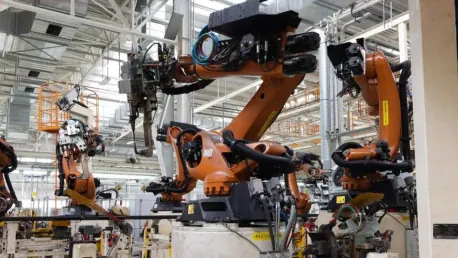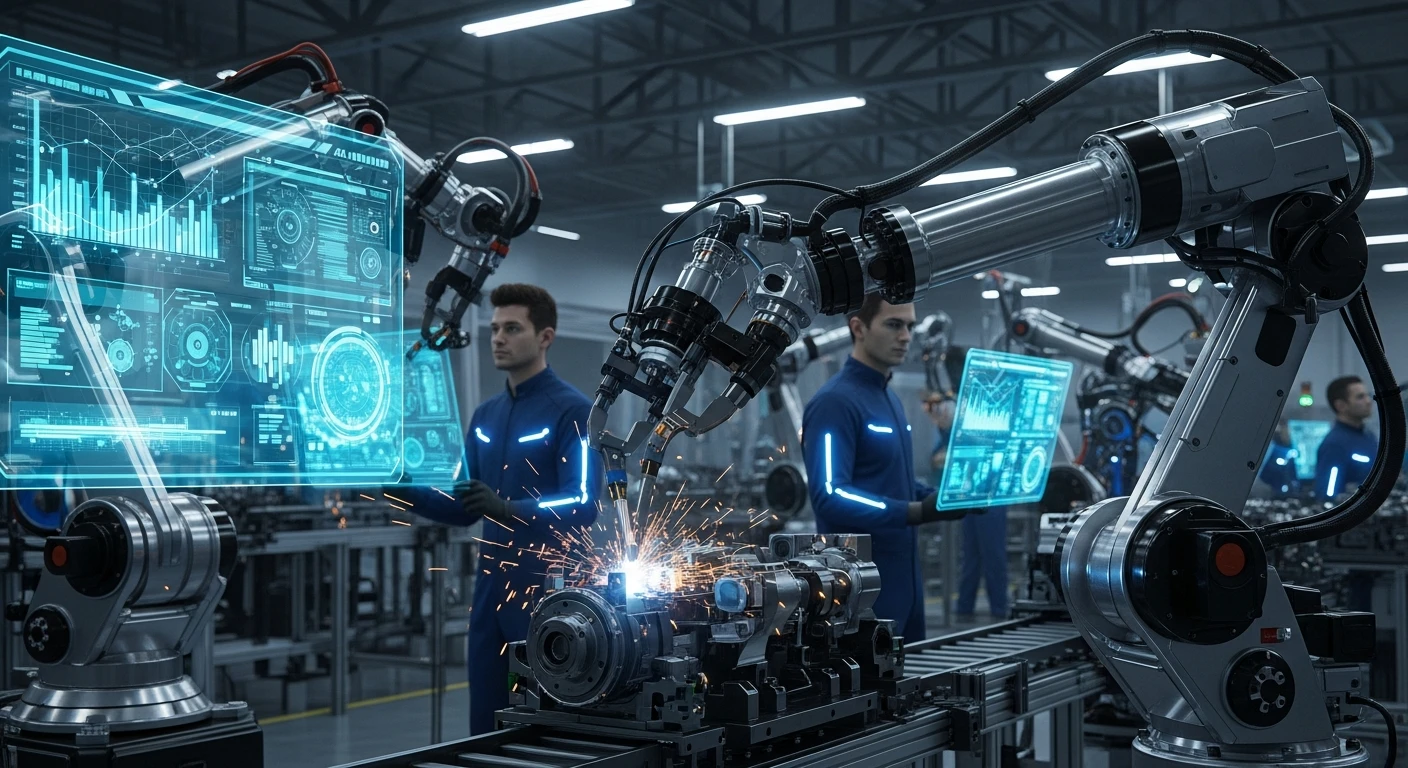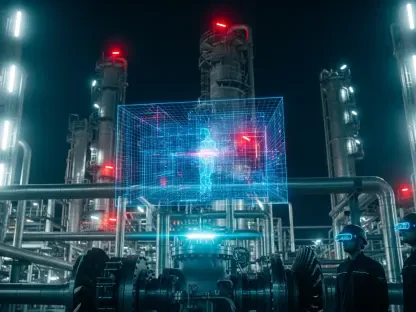The manufacturing industry is undergoing a transformative phase, driven by the integration of advanced robotics, artificial intelligence (AI), and sustainability initiatives. These advancements are reshaping production processes, enhancing efficiency, and addressing environmental concerns. The confluence of these technologies not only revolutionizes manufacturing techniques but also addresses critical challenges such as supply chain management, cybersecurity, and labor shortages. This comprehensive exploration delves into the various facets of this transformation, highlighting key trends and challenges that define the current and future landscape of manufacturing.
The Rise of Advanced Robotics in Manufacturing
The US automotive production sector is at the forefront of adopting advanced robotics, marking the advent of the fifth industrial revolution (5IR). This shift comes only a decade after the fourth industrial revolution (4IR) began, underscoring the rapid pace of technological evolution. The deployment of sophisticated robotics aims to enhance efficiency, precision, and operational quality, reflecting a broader trend across various industries toward increased automation. The significance of advanced robotics lies in its ability to streamline production processes and significantly reduce human error, thereby improving product quality.
Advanced robotics in manufacturing not only streamlines production processes but also improves product quality and reduces human error. These robots are capable of performing complex tasks with high accuracy, leading to significant improvements in productivity. As a result, manufacturers can meet growing consumer demands while maintaining a competitive advantage. However, the integration of advanced robotics also presents challenges, such as the need for skilled labor to operate and maintain these systems. This necessitates investment in workforce training and development to ensure that employees can effectively collaborate with robotic systems.
The advanced robotics revolution ushers in a new era of manufacturing where precision and efficiency are paramount. Yet, manufacturers must navigate the complexities associated with the adoption of such technologies. Training the workforce to handle and maintain these robotic systems is a crucial step toward maximizing their potential. It also raises the importance of robust safety protocols to ensure that the human-robot interaction in the workplace is secure and productive. By addressing these challenges, the manufacturing sector can fully leverage the benefits of advanced robotics and sustain long-term growth and innovation.
Strengthening Supply Chains with Technology
Effective supply chain management is crucial for the success of the manufacturing sector. Inaccuracies in demand forecasting can lead to stock shortages or excess inventory, each carrying substantial financial repercussions. To mitigate these risks, manufacturers are increasingly leveraging technology to enhance supply chain efficiency. Technologies such as AI and machine learning are being used to improve demand forecasting accuracy. By analyzing historical data and market trends, these technologies can provide more precise predictions, enabling manufacturers to optimize inventory levels and reduce waste. This not only enhances operational efficiency but also supports sustainability efforts by minimizing resource consumption.
Moreover, the adoption of technologies like the Internet of Things (IoT) allows for real-time monitoring of supply chain activities. This capability enables manufacturers to quickly identify and address potential disruptions, ensuring timely delivery of products and maintaining customer satisfaction. The integration of IoT technology into supply chain management systems provides manufacturers with a comprehensive view of their operations, facilitating more informed decision-making processes. This holistic approach to supply chain management not only improves efficiency but also enhances the overall resilience of the manufacturing process.
As manufacturers continue to embrace advanced technologies for supply chain optimization, the importance of data security cannot be overstated. Protecting sensitive supply chain data from cyber threats is critical to maintaining the integrity and reliability of the entire network. This requires the implementation of robust cybersecurity measures, such as encryption and access controls, to safeguard information. By prioritizing data security and leveraging innovative technologies, manufacturers can build resilient supply chains that are capable of adapting to evolving market conditions and sustaining long-term growth.
Enhancing Cybersecurity with Zero Trust Network Access
In the age of ‘continuous reinvention,’ as highlighted by PwC’s 27th Annual Global CEO Survey Report, cybersecurity has become a critical concern for manufacturers. Traditional network security strategies, such as Virtual Private Networks (VPNs), are increasingly being replaced by Zero Trust Network Access (ZTNA) to address evolving digital threats. ZTNA operates on the principle of “never trust, always verify,” ensuring that only authenticated and authorized users can access network resources. This approach provides a higher level of security compared to traditional VPNs, which often grant broad access to network resources once a user is authenticated.
The shift to ZTNA is driven by the need to protect sensitive manufacturing data and intellectual property from cyberattacks. As manufacturers adopt more connected technologies, the attack surface expands, making robust cybersecurity measures essential. By implementing ZTNA, manufacturers can safeguard their operations and maintain the integrity of their digital infrastructure. This proactive approach to cybersecurity is crucial in an era where cyber threats are becoming increasingly sophisticated and persistent. It emphasizes the importance of continuous monitoring and verification to ensure that only legitimate users have access to critical systems.
Implementing ZTNA involves rethinking traditional network security paradigms and adopting a zero-trust mindset. This includes segmenting networks to limit the potential impact of a breach and enforcing strict access controls based on user identity and context. Additionally, continuous monitoring of network activity is essential to detect and respond to potential threats in real-time. By adopting ZTNA, manufacturers can enhance their cybersecurity posture and protect their digital assets against a rapidly evolving threat landscape. This strategic approach to cybersecurity ensures that manufacturing operations remain secure, resilient, and capable of supporting ongoing technological innovation.
Addressing Talent Shortages in US Manufacturing
The US manufacturing sector is facing significant labor shortages due to factors such as reshoring efforts, a retiring workforce, and advancements requiring new skill sets. Sixty-five percent of manufacturers identify attracting and retaining talent as their primary business challenge. To address this issue, manufacturers are investing in talent development initiatives. This includes partnerships with educational institutions to create training programs that equip workers with the necessary skills for modern manufacturing roles. Additionally, manufacturers are offering competitive wages and benefits to attract and retain skilled workers.
The development of a skilled workforce is essential for the continued growth and competitiveness of the US manufacturing sector. By prioritizing talent development, manufacturers can ensure a resilient future and maintain their position in the global market. Effective talent development strategies involve not only technical training but also fostering a culture of continuous learning and innovation. This approach encourages employees to stay abreast of technological advancements and contribute to the industry’s ongoing transformation. Investing in the workforce’s development creates a pipeline of skilled talent capable of meeting the demands of the modern manufacturing landscape.
Moreover, addressing talent shortages requires a multifaceted approach that includes enhancing job attractiveness and creating clear career paths for workers. By providing opportunities for professional growth and advancement, manufacturers can improve employee retention and build a loyal, motivated workforce. Collaboration with vocational schools, community colleges, and industry associations can also help bridge the skills gap and ensure that training programs align with industry needs. As the manufacturing sector continues to evolve, these efforts will be critical in attracting and retaining the talent necessary to drive innovation and sustain industry growth.
The Impact of Political Shifts on Global Trade
Political shifts, such as the outcomes of US elections, have significant implications for global trade policies and mergers and acquisitions (M&A). For instance, a Trump administration may adopt protectionist trade measures to reduce reliance on China, reshaping the global supply chain landscape. These changes can create both opportunities and challenges for manufacturers. On the one hand, protectionist policies may encourage domestic production and reduce dependency on foreign suppliers. On the other hand, they may lead to increased costs and supply chain disruptions.
Manufacturers must stay informed about political developments and be prepared to adapt their strategies accordingly. This includes diversifying supply chains, exploring new markets, and staying agile in response to changing trade policies. By proactively assessing potential political impacts on their operations, manufacturers can develop contingency plans to mitigate risks and capitalize on new opportunities. This strategic approach to navigating political shifts ensures that manufacturing operations remain resilient and capable of maintaining competitiveness in an evolving global landscape.
The dynamic nature of global trade underscores the necessity for manufacturers to remain flexible and responsive to external changes. This involves continuously monitoring geopolitical developments and adjusting business strategies to align with new trade policies and regulations. By fostering strong relationships with diverse suppliers and customers, manufacturers can enhance their adaptability and reduce exposure to potential disruptions. In the face of political uncertainty, a proactive and flexible approach to global trade will be essential in sustaining growth and maintaining a competitive edge in the market.
Leveraging Large Format Additive Manufacturing
Large-format additive manufacturing (LFAM) is an innovative production method that offers significant cost and time savings for manufacturers. By enabling the production of large components in a single process, LFAM reduces the need for assembly and minimizes material waste. Manufacturers assessing the viability of LFAM must consider factors such as the types of parts that can benefit from this technology and the potential return on investment. For those already using LFAM, continuous evaluation and optimization of the process are essential to maximize its benefits. This innovative approach allows manufacturers to streamline production workflows and achieve greater efficiency.
The adoption of LFAM represents a significant shift in traditional manufacturing techniques. By leveraging LFAM, manufacturers can produce complex geometries and customized parts with greater precision and reduced lead times. This capability is particularly valuable in industries such as aerospace, automotive, and construction, where large, complex components are common. Additionally, LFAM supports sustainability efforts by reducing material waste and enabling the use of eco-friendly materials. As manufacturers embrace this technology, it is essential to continuously explore new applications and optimize processes to fully realize the potential benefits of LFAM.
Furthermore, LFAM can enhance the flexibility and responsiveness of manufacturing operations. By producing components on-demand and reducing reliance on extensive inventory, manufacturers can adapt more quickly to changes in market demand. This agility is crucial in today’s fast-paced business environment, where the ability to respond promptly to customer needs can provide a significant competitive advantage. By integrating LFAM into their production strategies, manufacturers can drive innovation, improve operational efficiency, and support sustainable growth.
Conclusion
The manufacturing industry is experiencing a significant transformation fueled by the integration of advanced robotics, artificial intelligence (AI), and sustainability efforts. These technological advancements are revolutionizing production processes, improving efficiency, and addressing environmental concerns. The fusion of these technologies is reshaping not only manufacturing methods but also tackling crucial issues such as supply chain management, cybersecurity, and labor shortages. By leveraging AI and robotics, manufacturers can enhance precision and reduce costs, while sustainable practices help minimize environmental impacts. This comprehensive overview examines the various aspects of this shift, spotlighting key trends and challenges that define the current and future state of manufacturing. The focus is on how these innovations are creating a more resilient and efficient manufacturing landscape, capable of meeting the demands of a rapidly evolving global market. As the industry continues to evolve, understanding these dynamics is essential for stakeholders aiming to stay competitive and navigate the complexities of modern manufacturing.









